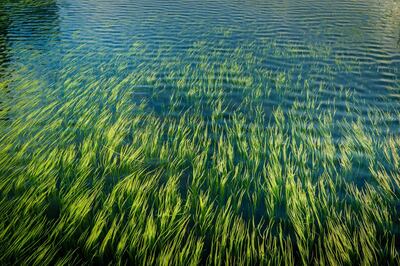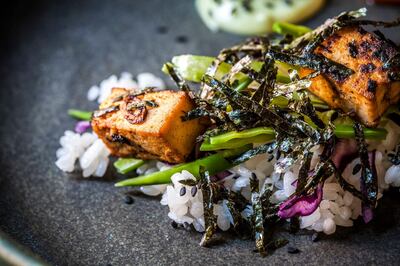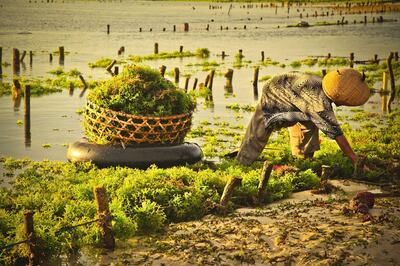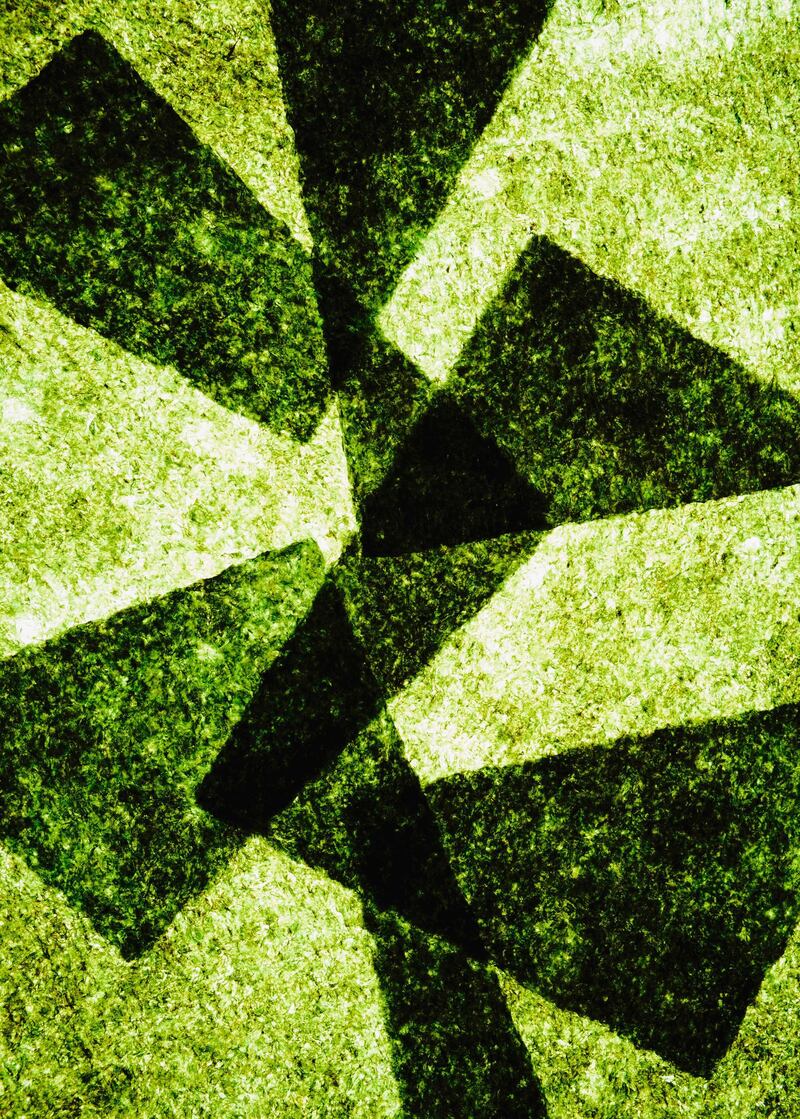Seaweed has slithered into our lives surreptitiously. The closest we might think we get to it is when ordering nori-wrapped sushi. Asked if we’d like to eat more of it, we might recoil.
In reality, however, we probably consume seaweed during most meals. Itemised on ingredients lists as agar, alginates, carrageenan or simply as a “stabiliser and emulsifier”, seaweed extracts are a mainstay of the food industry.
From ice cream to face creams
These gloopy gels also underpin the skincare, cosmetics and toiletries industries, as well as the pharmaceutical, animal-feed and fertiliser sectors. They give chocolate milk and frozen cheesecake their delightfully smooth consistencies, help lipstick to glide on, pills to slide down, shampoos to flow and dental moulds to stay flexible. Seaweed is even the secret of Hollywood’s favourite $300 moisturiser, Crème de La Mer. The “miracle broth” is primarily crafted from giant kelp.
And now, seaweed seems poised to step out of the wings and take centre stage.
Scientists are calling it our last great natural renewable resource. As the post-Covid reset gets under way, the eye-watering debts built up in dealing with the pandemic make it imperative that we find sustainable, low-cost ways of addressing the other big challenges confronting us.
Seaweed, an unsung hero, on this planet three billion years before human beings arrived, and then responsible for nourishing people and animals, as well as poor soil, for millennia, could be the solution to a number of global problems. Not least how to feed the planet’s ever-growing population, as well as mitigate climate change.
The climate warrior
Seaweed grows in every one of the seas and oceans that together cover 71 per cent of our planet. It is still quite mysterious, but it’s now known there are about 11,000 species of the plant, divided into three main types: brown, red and green. Kelp is the most common. Huge underwater forests known as the Great Kelp Highway stretch across the North Pacific from Japan to Alaska, then down the north-west coast of Canada and North America to California.
Numerous species grow abundantly in the clear cold waters around rocky-shored Ireland and Britain, from Norway around to Portugal, and along the north-east Atlantic coast of Canada and North America. Other species grow better in the warm waters of the southern Pacific and the Caribbean Sea.

Fantastic nutritiousness is seaweed’s main claim to future planet-feeding fame. Spirulina and chlorella are familiar health food store supplements, and certain macroalgae, as seaweeds are classified, are similarly nourishing. Although the amounts depend on species, where and when it’s harvested, and whether it is eaten raw or processed, seaweed can be packed with minerals and vitamins – among them calcium, iodine, iron, magnesium, potassium, zinc, and vitamins A, B1, B2, B3, B6, B12, C and E.
Some species have 10 times more calcium than milk, eight times more iron than red meat, and more protein than poultry, eggs or beans. Low-calorie, low-carb, fat-free and perfect for vegans, seaweed easily outshines most land-produced foods.
One of humanity's first foods
Remains found in 12,000-year-old pottery in Japan – which consumes more seaweed than anywhere else in the world – proves that it was one of humanity’s first foods. But while Asia has never stopped eating the plant, it was mostly disdained in the West. It wasn’t until the 1960s, when Japan started enjoying massive success in exporting nori as sushi became popular first in hippy California, then in Europe and beyond, that scientists in the West started to pay serious attention to seaweed’s potential.

It started being used as a food additive in the 1930s. Carrageenan, produced off the coast of Maine (having been introduced there in the 19th century by immigrants escaping the potato famine in Ireland, where the stuff was traditionally used to thicken foods), was substituted for agar when the Second World War cut off supplies from Japan.
But seaweed’s commercial use really took off as consumption of processed food rocketed. Demand for larger supplies of seaweed extract led to an increase in its farming in China (now the world’s biggest exporter of seaweed), and launched farming in Indonesia and the Philippines. A scattering of seaweed farms also sprang up along the US, Canadian and Norwegian coasts. Research stations followed. And the findings have scientists excited.
Cruelty-free farming
Seaweed grows at almost twice the rate of any land crop. Left to its own devices, a bulb fixes itself in the seabed and then grows a long hollow tube up towards the surface, so it can access the nutrients deep in the water as well as sunlight and oxygen nearer the surface.
A seaweed farm involves either planting the crop on the seabed – nori, for instance, grows well on cockle shells – or working from the surface, dropping nylon lines seeded with spores down into the water or extending racks out from the shore. And that’s it. Unlike land crops, seaweed doesn’t need fertiliser or pesticide. Four or five months later, the kelp will be several yards long, at which point it can be cut away, harvested and processed.

A seaweed farm causes nowhere near the amount of pollution that traditional farms can, with their vast amounts of toxic slurry poisoning local land and water. It doesn’t involve any cruelty, unlike the industrialised farming of chicken, cattle and pigs. Although processing the harvested seaweed – washing out any sand or insects, and then boiling or drying it – involves buildings, equipment and staff, this is a relatively low-cost industry that provides employment for the poorest, least educated people in the world.
Seaweed’s other potentially planet-saving ability is that it absorbs massive amounts of carbon dioxide. Mixed with animal feed, it also greatly reduces the methane emitted by cattle. A question mark hangs over its potential as a biofuel to replace oil, partly because of the massive quantities that would have to be produced. But in the past decade, its use as a salt substitute, as degradable packaging and as a building material has been proven.
An ancient medical aid
Its potential as medicine also looks promising because seaweed has such a long history of treating illness. In 300 BC, writer Chi Han recorded how the Chinese routinely used brown seaweed to treat migraines, oedema, lipomas, infections and cysts. In the ninth century, sophisticated Arab pharmacists used seaweed to treat jaundice, spleen, kidney and skin conditions, as well as malignancies. Incidentally, Arabs also pioneered coating their ships with agar as a protective measure against fire, a technology that is the basis of fireproofing still used today.
Treating cancer with brown seaweed, in particular, has been yielding positive results in Japan for centuries, despite a lack of scientific research. But recent laboratory research in Japan and elsewhere around the world into fucoidan, which is found in brown seaweed, has been showing intriguing results. A report on The Seaweed Site cites research in Japan that shows fucoidan in kombu and wakame can slow the growth of cancer cells and even cause cancer cells to self-destruct. It also notes that Japan’s Okinawans, who eat more seaweed than anyone else, including kombu, raw rather than cooked, are not only the world’s longest-living community, but have Japan’s lowest mortality rates from cancer.
And only weeks ago, researchers at the University of Chinese Academy of Sciences in Beijing issued a study showing the seaweed Ecklonia kurome – Kun Bu in China, where it is used extensively in traditional medicine – blocks an enzyme essential for the coronavirus to reproduce.
Sea-based skincare
While we wait for further developments, we can always slather on a seaweed-infused face mask or moisturiser. Katy Rowe, founder of skincare brand Maiiro, uses the fucoidan in seaweed from the pristine waters around Guernsey in her products. Haeckels has recently launched its Eco Marine skincream with UV properties, and Thalgo has opened a new marine day spa in Cannes. Numerous spas, including The Original FX Mayr in Austria, use Sodashi's seaweed-based products, and the Scottish company Ishgar and American One Ocean Beauty are also expanding their ranges in response to eager customers. Wild Irish Seaweed sends seaweed-based foods worldwide.
Or we could loll in a bath brimming with the stuff. Thanks to the beneficial effect on rheumatic joints and cellulite, the 19th century tradition of seawater baths remains alive on the west coast of Ireland, where at the bathhouse in County Sligo now run by the pioneering seaweed-skincare company Voya (which supplies Burj Al Arab, among other five-star resorts), you can sink into steaming hot water that’s almost obscured by thick undulating fronds of kelp.
For a full immersion into the promising new world that seaweed could offer, the Seaweed Site (seaweed.ie) and the chattier Algae Now (algaeworld.org) may leave you feeling rather more cheerful about the future than you might otherwise be.







